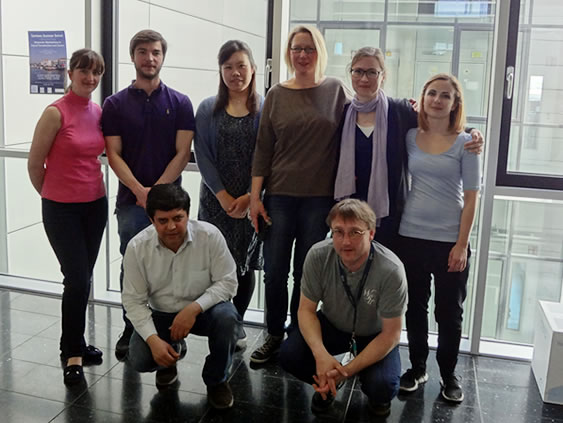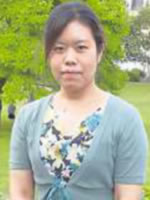Scientific Report
(1) Difficulties in the treatment of Adult Acute lymphoblastic leukemia
Acute lymphoblastic leukemia (ALL) is a neoplasm of immature lymphoid progenitors 1,2. It is the most common hematopoietic tumor in children and accounts for 25% of all adult leukemias. Although more than 80% of pediatric ALL cases are curable, many patients with adult ALL fail to respond to either chemotherapy or hematopoietic stem cell transplantation 1,2. The two major problems in the treatment of adult ALL are relapse and therapy resistance. The complete remission rate in adult ALL is about 70–80% but the relapse rate is also high and relapsed patients have poor prognoses 3,4. In my own practice, I have treated many patients whose life expectancy might have been longer if they could have received therapy capable of overcoming resistance. Novel therapeutic approaches to eradicate resistant leukemic cells are warranted.
In Philadelphia chromosome (Ph)-positive ALL (Ph+ ALL), cellular transformation and leukemogenesis are dependent on the tyrosine kinase activity of the Breakpoint cluster region and ABL1 (BCR-ABL) fusion protein which is considered an absolute poor prognostic factor. Since the 2000s, tyrosine kinase inhibitors (TKI) have been used in the treatment of Ph+ ALL and the outcome has dramatically improved 5. However, the main problem in treatment of Ph+ ALL is acquired resistance. Point mutations in the tyrosine kinase domain of BCR-ABL have emerged as the predominant cause of acquired resistance 6-10.
In contrast, different problems impede the treatment of Ph-negative ALL (Ph- ALL). While outcomes in other hematopoietic disorders have greatly improved with the development of novel therapeutics, there has not been a major change in the outcome of adult Ph- ALL in Japan in the last 10 years 1,2. Overseas, molecular targeted therapies such as calicheamicin-conjugated anti-CD22 monoclonal antibody, Inotuzumab ozogamicin 11 or the anti-CD19/CD3 bispecific antibody, Blinatumomab 12 have been reported, but longer follow-up is necessary before these can be applied clinically in Japan. Hematopoietic stem cell transplantation during first remission is absolutely indicated in Ph+ ALL; in recent years transplantation during first remission has tended to be performed in Ph- ALL as well 13. However, there is still a high rate of therapy-related mortality and discussion of the indications remains divided. In order to develop innovative molecular targeted therapies, it will be necessary to elucidate the molecular mechanisms that are key to the growth and survival of Ph- ALL cells.
(2) Approaches to novel inhibitors in Johann Wolfgang Goethe University
A substantial amount of groundbreaking research into adult ALL is being conducted at the Johann Wolfgang Goethe University in Germany. The world-renowned professor Oliver G. Ottmann has performed numerous clinical trials of new molecular targeted therapies for adult ALL including 2nd and 3rd generation TKIs 14-18. The center houses more than 3,000 archived samples from Ph+ ALL patients. As ALL is my primary area of research interest, it has been one of my long-time dreams to join the Ottman group and further my understanding of this disease. Since joining the lab in November in 2014, I have focused on two main projects. The first is an investigation of a selective B cell lymphoma/leukemia 2 (BCL-2) inhibitor ABT-199 as a new therapeutic approach in adult ALL, and the second is a study of TKI resistance mechanisms in Ph+ ALL.
BCL-2 is a member of the BCL-2 protein family whose members are key regulators of apoptosis and cell death via the intrinsic apoptosis pathway at the mitochondrial membrane. BCL-2 contributes to cancer cell survival and its over-expression is related to therapy resistance in a broad spectrum of cancers 19,20. Several hematological malignancies are characterized by a high BCL-2 expression including chronic lymphocytic leukemia, mantle cell lymphoma, follicular lymphoma, as well as numerous solid tumors 20,21. BCL-2 transcripts are over-expressed in primary T-ALL patient cells 22, and highly aggressive early T-cell precursor leukemia 23 cells are dependent on BCL-2 for survival 24. The role of BCL-2 as a potential drug target in ALL has not been thoroughly investigated, but BCL-2 inhibitors can have some important roles, especially in combination with conventional drugs.
Point mutations in the ABL moiety of the BCR-ABL fusion protein that interfere with its binding affinity to kinase inhibitors are found in the majority of TKI-resistant Ph+ ALL cases and these are selected for by exposure to TKI. The most frequent mutations are the catalytic domain mutation M351T, the activation loop mutation H396P, the P-loop mutations Y253F and E255K, and the gatekeeper mutation T315I 9. All TKIs, with the exception of Ponatinib, are ineffective against BCR-ABL carrying the T315I mutation which is critical for patient management.
Although conventional ALL cell lines have been used for the investigation, there has been an under-representation of adult ALL. Recently, in our group, a unique culture system has been established for primary cells from ALL patients, which remain genetically as well as immunophenotypically stable for at least 6 months without entering senescence or passing the typical crisis of cell lines 17,25,26. Of the patient-derived long-term cultures (PD-LTCs) available, three had p185BCR/ABL. Non-mutated TKI-resistant cells and PD-LTCs harboring the p185BCR/ABL T315I mutation are also available. By using this culture system for primary cells, I investigated inhibition of ALL cell growth and apoptosis by novel molecules that inhibit several potential molecular targets in ALL. Candidate inhibitors I investigated included not only ABT-199 and TKIs (Ponatinib, PF11426), but also the pan PI3 kinase inhibitor NVP-BKM120 17, a potent allosteric inhibitor of BCR-ABL (ABL001), and other novel inhibitors. The efficacies of these agents were also investigated when used in combination.
(3) Lab meetings and clinical rounds
I joined the weekly meetings that all members of the laboratory attended. They included in-depth discussions about the group's research from many perspectives. I found these meetings very informative and inspiring.
I also joined the clinical round of hematopoietic stem cell transplantation ward. This was a valuable learning experience because it allowed me to compare the German clinical practice with the Japanese one, and I concluded that Japanese medicine is influenced considerably by that of Germany.
(4) My future directions and aims in Japan
In Japan, there are many specialists in pediatric ALL, but unfortunately, not so many researchers or institutes that focus on adult ALL. Although clinical trials in adult ALL have been performed by the Japan Adult Leukemia Study Group (JALSG), we have not achieved satisfactory results. I believe that novel diagnostic and therapeutic strategies for adult ALL are needed in Japan. I would therefore like to return to Japan in the future with more advanced research skills to contribute towards better treatment of Japanese adult ALL patients.
(5) Acknowledgement
I am grateful to Prof. Oliver G. Ottmann for accepting me to be a member of his group. I would also like to thank Dr. Martin Ruthardt, Dr. Afsar Ali Mian, Dr. Claudia Oancea, Dr. Gesine Bug, Dr. Fabian Lang and all members of the Department of Medicine, Hematology/Oncology Johann Wolfgang Goethe University.
I thank Prof. Junji Tanaka, who is a mentor of my home institution and Prof. Shinya Kimura in the Division of Hematology at Saga University, who was working in the Department of Medicine, Hematology/Oncology Johann Wolfgang Goethe University formerly. I am deeply grateful to EHA and JSH for giving me such a wonderful experience.
References
- 1. Pui C, Robison L, Look A. Acute lymphoblastic leukaemia. Lancet. 2008;371(9617):1030-1043.
- 2. Faderl S, O'Brien S, Pui C, et al. Adult acute lymphoblastic leukemia: concepts and strategies. Cancer. 2010;116(5):1165-1176.
- 3. Inaba H, Greaves M, Mullighan CG. Acute lymphoblastic leukaemia. Lancet. 2013;381(9881):1943-1955.
- 4. Bassan R, Hoelzer D. Modern therapy of acute lymphoblastic leukemia. J Clin Oncol. 2011;29(5):532-543.
- 5. Lee HJ, Thompson JE, Wang ES, Wetzler M. Philadelphia chromosome-positive acute lymphoblastic leukemia: current treatment and future perspectives. Cancer. 2011;117(8):1583-1594.
- 6. Soverini S, Iacobucci I, Baccarani M, Martinelli G. Targeted therapy and the T315I mutation in Philadelphia-positive leukemias. Haematologica. 2007;92(4):437-439.
- 7. Branford S, Hughes TP. Mutational analysis in chronic myeloid leukemia: when and what to do? Curr Opin Hematol. 2011;18(2):111-116.
- 8. Pfeifer H, Wassmann B, Pavlova A, et al. Kinase domain mutations of BCR-ABL frequently precede imatinib-based therapy and give rise to relapse in patients with de novo Philadelphia-positive acute lymphoblastic leukemia (Ph+ ALL). Blood. 2007;110(2):727-734.
- 9. Shah NP, Nicoll JM, Nagar B, et al. Multiple BCR-ABL kinase domain mutations confer polyclonal resistance to the tyrosine kinase inhibitor imatinib (STI571) in chronic phase and blast crisis chronic myeloid leukemia. Cancer Cell. 2002;2(2):117-125.
- 10. Soverini S, Colarossi S, Gnani A, et al. Contribution of ABL kinase domain mutations to imatinib resistance in different subsets of Philadelphia-positive patients: by the GIMEMA Working Party on Chronic Myeloid Leukemia. Clin Cancer Res. 2006;12(24):7374-7379.
- 11. Kantarjian H, Thomas D, Jorgensen J, et al. Inotuzumab ozogamicin, an anti-CD22-calecheamicin conjugate, for refractory and relapsed acute lymphocytic leukaemia: a phase 2 study. Lancet Oncol. 2012;13(4):403-411.
- 12. Klinger M, Brandl C, Zugmaier G, et al. Immunopharmacologic response of patients with B-lineage acute lymphoblastic leukemia to continuous infusion of T cell-engaging CD19/CD3-bispecific BiTE antibody blinatumomab. Blood. 2012;119(26):6226-6233.
- 13. Kako S, Morita S, Sakamaki H, et al. A decision analysis of allogeneic hematopoietic stem cell transplantation in adult patients with Philadelphia chromosome-negative acute lymphoblastic leukemia in first remission who have an HLA-matched sibling donor. Leukemia. 2011;25(2):259-265.
- 14. Ottmann OG, Pfeifer H. Management of Philadelphia chromosome-positive acute lymphoblastic leukemia (Ph+ ALL). Hematology Am Soc Hematol Educ Program. 2009:371-381.
- 15. Mian AA, Metodieva A, Najajreh Y, Ottmann OG, Mahajna J, Ruthardt M. p185(BCR/ABL) has a lower sensitivity than p210(BCR/ABL) to the allosteric inhibitor GNF-2 in Philadelphia chromosome-positive acute lymphatic leukemia. Haematologica. 2012;97(2):251-257.
- 16. Topp MS, Gökbuget N, Zugmaier G, et al. Long-term follow-up of hematologic relapse-free survival in a phase 2 study of blinatumomab in patients with MRD in B-lineage ALL. Blood. 2012;120(26):5185-5187.
- 17. Badura S, Tesanovic T, Pfeifer H, et al. Differential Effects of Selective Inhibitors Targeting the PI3K/AKT/mTOR Pathway in Acute Lymphoblastic Leukemia. PLoS One. 2013;8(11):e80070.
- 18. Jabbour E, Ottmann OG, Deininger M, Hochhaus A. Targeting the phosphoinositide 3-kinase pathway in hematologic malignancies. Haematologica. 2014;99(1):7-18.
- 19. Cory S, Huang DC, Adams JM. The Bcl-2 family: roles in cell survival and oncogenesis. Oncogene. 2003;22(53):8590-8607.
- 20. Tam KF, Liu VW, Liu SS, et al. Methylation profile in benign, borderline and malignant ovarian tumors. J Cancer Res Clin Oncol. 2007;133(5):331-341.
- 21. Tsujimoto Y, Cossman J, Jaffe E, Croce CM. Involvement of the bcl-2 gene in human follicular lymphoma. Science. 1985;228(4706):1440-1443.
- 22. Anderson NM, Harrold I, Mansour MR, et al. BCL2-specific inhibitor ABT-199 synergizes strongly with cytarabine against the early immature LOUCY cell line but not more-differentiated T-ALL cell lines. Leukemia. 2014;28(5):1145-1148.
- 23. Coustan-Smith E, Mullighan CG, Onciu M, et al. Early T-cell precursor leukaemia: a subtype of very high-risk acute lymphoblastic leukaemia. Lancet Oncol. 2009;10(2):147-156.
- 24. Chonghaile TN, Roderick JE, Glenfield C, et al. Maturation stage of T-cell acute lymphoblastic leukemia determines BCL-2 versus BCL-XL dependence and sensitivity to ABT-199. Cancer Discov. 2014;4(9):1074-1087.
- 25. Nijmeijer BA, Szuhai K, Goselink HM, et al. Long-term culture of primary human lymphoblastic leukemia cells in the absence of serum or hematopoietic growth factors. Exp Hematol. 2009;37(3):376-385.
- 26. Mian AA, Rafiei A, Haberbosch I, et al. PF-114, a potent and selective inhibitor of native and mutated BCR/ABL is active against Philadelphia chromosome-positive (Ph+) leukemias harboring the T315I mutation. Leukemia. 2015;29(5):1104-1114.


